|
A proverb says that the tender calf of two queens sucks. not the calf, but also the two owners live, but only not the benefit, but harm brings them, but sucks juice. Classification: - helminth refers to the animal kingdom;
- subsection of Primordial;
- type Flat (Cestodes);
- belt class;
- chain or Cyclofillidae;
- the family Teniida;
- mind Bullseye.
Tapeworms are often called tapeworms (from the Latin solitarius, solitary tape - solitary). Why? Yes, because in the intestines really live alone. Why does tapeworm belong to flatworms? Because the worm is flat - the body is flattened from the sides. Why belongs to the class of tape? Because an adult individual has a thin, ribbon-like body. Structural featuresThe organs of the bull chain can be divided into three sections: the head, neck, body. Description of the bodies: - The rounded head (scolex) has a small size (1–2 mm), four suction cups. There are no hooks, like y, so the bull chain is also called unarmed.
- The neck is a zone of growth of the helminth; it constantly forms new segments budding but not separated from the strobila.
- The body (strobilus) consists of a huge number of segments or proglottids. The number of segments in adults may be up to 1000.
The length of the bovine tapeworm reaches up to 6–10 meters, the pork tapeworm has a similar structure (), but the body is milder, up to 4 meters. Rarely in humans, mainly in children, there is a small pygmy tapeworm.
Morphology of segments: young proglottids of a bovine chain of the square form, hermaphroditic (there are ovaries and testicles). Each mature segment increases in size, contains up to 150 thousand eggs in the overgrown, branched uterus. Detached segments are able to move independently to the exit from the intestine, which causes discomfort in a person. The chain of bull is considered ubiquitous helminth. But there are areas: - with higher epidemicity - the countries of Africa, Asia, especially Mongolia;
- with moderate infestation - Australia, Philippines;
- with minimal infection - North America, European countries, Yakutia, Altai Krai, RF (livestock areas).
Habitat: inhabits the body of cows, bulls, deer, human intestines. To live in the small intestine of a person, if de-worming is not carried out, the helminth may be up to 18 years old, sometimes up to 20 Life cycleLife cycle stages: - Eggs
- Larvae living in the muscles of animals. Finns.
- Adult worms in the human intestine, laying eggs. The cycle is closed.
- Infection occurs when animals eat grass with eggs. Animals - cattle - are the intermediate host of the tapeworm and the carrier of the disease.
- Eggs are very viable, keep a little cold and winter in the ground. The eggs develop larvae that can penetrate through the intestinal walls into the blood, then muscular, connective tissue, where they settle. Four months later, Finns form from larvae, which look like small peas and retain their viability for up to 9 months. The larvae are small, so the Finns in the piece of meat can be overlooked. The meat affected by the Finns is called Finnish.
- The main owner of the bull chain is man. Ways of infection: you can become infected by eating infected, insufficiently cooked, roasted meat, raw reindeer brain. Once in the intestine, the Finn twists its head, attaches to the mucous membrane - the formation of new segments of the animal begins.
The proglottid worm continues to develop for about 80 days, then mature helminth segments come off, along with feces or leave the body on their own. Eggs from a segment of a bovine tsepny fall on a grass. The life cycle is closed.
 The main symptoms of the disease: The main symptoms of the disease:
- common: headache, weakness, fatigue;
- on the part of the digestive system: nausea, accompanied by vomiting, increased salivation, dyspepsia, and sometimes constipation, lack of appetite, bulimia;
- spilled pain sensations in the abdomen;
- obvious signs - the appearance of segments in the feces or their independent selection, on average, up to 6–8 segments of the bovine chain in a day depart.
Danger of contracting teniarinhozWhat is dangerous bullish tapeworm? Dangerous serious complications: - necrosis and perforation of the pancreas;
- the development of acute cholecystitis;
- allergic reactions to the waste products of helminth;
- biliary and intestinal colic;
- intestinal obstruction.
Preventive actions- purchase of meat, meat products only in specialized stores;
- veterinary control of meat products on the market;
- compliance with the technology of cooking meat dishes.
Remember - helminthic invasions are easier to prevent than to heal. On the treatment of bovine tapeworm, read.
Discovery history

Morphology and bullseye: photo
Conditions for successful completion of the life cycle
1. The proglottids filled with eggs enter the environment through faeces. 2. These “pregnant” segments invade cattle eating contaminated vegetation so they enter into digestive tract intermediate host. Enzymes and acids, which are contained in the gastrointestinal juice, break the protective barrier and release up to 100,000 eggs. 3. Eggs develop into larvae that break through the intestinal epithelium and travel through the body of cattle. Then the maggots get into muscle tissue, their oncosphere is filled with fluid, forming cysts. 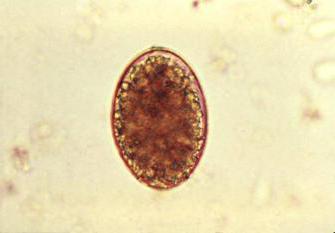
Life Cycle Scheme

Body clinging
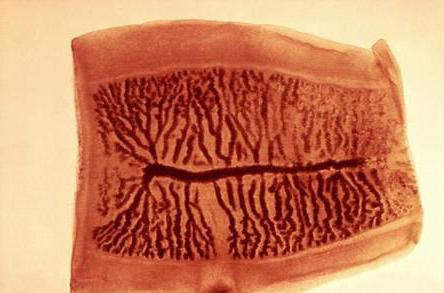
Breeding

Signs, symptoms, and diagnosis of infectionInfection with a bull chain is accompanied only mild symptomsincluding diarrhea, constipation, flatulence, abdominal pain, and weight loss. How do doctors diagnose and treat the infection? Eggs and proglottids can be seen in stool specimens during microscopic examination. In order to accurately determine that the tapeworm is bovine or swine, it is necessary to remove and examine their scolex. This is rarely done, as doctors usually prescribe the same medication for both types of infection. Helminth larvae in tissue cyst tissues can be detected using X-ray, as well as computed tomography (brain cysts). Monitoring is also performed at 3 and 6 months after treatment to make sure that the infection is gone permanently.

Bullseye causes teniarinhozGroup related tapeworms bullish tapeworm is a fairly large specimen that causes an infection called teniarinhoz. It received its name due to the fact that it uses cows as intermediate hosts. People are only final carriers. The disease is often asymptomatic. In the severe stage, it can sometimes cause inflammation of the appendix and bile ducts. Infection can also jeopardize immune system. The consequences of infection can have a particularly profound effect on the health of young children. Teniarinhoz is found everywhere and is relatively common in Africa, Eastern Europe, Latin America and the Philippines. Treatment
PreventionTapeworms can cause intestinal diseases and other severe pathologies. Infection with a bull chain can be prevented by thoroughly cooking the meat, this ensures that any chain cysts are destroyed. Alternatively, you can freeze the meat and hold it at a temperature below -5 ° C for several days. Preventing infection of cattle is also eating in those areas where the vegetation can not be contaminated with human feces. A reliable method to prevent endemic spread is the detection of infected livestock. It is also important to follow the rules of hygiene and maintain cleanliness, which involves regular hand washing, especially after using the toilet. Proper sanitation is the key to eliminating infection worldwide.
- Date: 04/23/2015
- Views: 213
- Comments: 0
- Rating: 17

Figure 1. Diagram of the development cycle of the bull chain.
The feces infected with the oncospheres of the bovine tapeworm fall onto the soil, hay. They are not afraid of mild cold and can spend the winter in the soil. But under the influence of ultraviolet radiation and a temperature of 30-37 degrees oncospheres perish.
The intermediate host of the bull chain is cows, bulls, deer, buffaloes. These animals, feeding on grass infected with helminth eggs, become carriers of the disease.
The larva of the bovine chain through the walls of the cattle’s intestine is able to penetrate the bloodstream, spread throughout the body and settle in the muscles, in connective tissue. Here the larvae develop in cysticercus in 4 months. These are the so-called Finnish bull chains. In the body of livestock, they can live for about nine months, then die. In fig. 1 depicts the development cycle of a bull chain.
In the intestines of a human Finn gets through contaminated, raw or poorly roasted meat. Here it is transformed, the head with suction cups is exposed to the outside and is firmly fixed on the mucous membrane. Then begins the formation of an adult tapeworm.
The development of the bovine chain of cysticerci in the human body occurs within 80 days. After this, the mature segments of the helminth come off and go along with the human feces. So life cycle bovine chain closes and repeats again.
The main signs of helminth infection and its diagnosis
- the nervous system is upset, there is increased fatigue, weakness, headaches and insomnia;
- heartburn, nausea, vomiting, dyspepsia or constipation, abnormal salivation;
- non-localized pain in the abdomen, without a specific place: in the stomach, on both sides of the abdomen or in its lower part;
- a sharp change in appetite from a complete lack to a strong hunger;
- the main and indisputable sign of infection with a bovine chain is the exit of the segments of the worm through the anus on its own or with feces.
It is difficult to diagnose bovine chain infection, especially at the initial stage due to poorly pronounced symptoms. To determine the diagnosis is used: If infection with this helminth could not be detected on early stagethen in a later period there may be complications of the course of the disease in the form of intestinal obstruction, perforation of its walls and, as a consequence, the occurrence of peritonitis, pancreatitis, appendicitis, disruption of the biliary system. The outcome of the disease in most cases is positive.
Disease treatment and prevention of bovine chain infection
After a quarter of an hour take Fenasal, dissolved in 100 ml of sweetened water. The exact dosage is strictly prescribed by a doctor, on average it is no more than 2-3 g for an adult patient. Bovine tapeworm in humans is also removed using dry fern extract, pumpkin seeds and cleansing enemas, which are made the evening before taking a herbal remedy and in the morning on the day of treatment. For the prevention of the disease requires to abandon the use of raw or undercooked meat. The time of roasting or cooking meat for at least an hour. For information: the helminth Finns inside large pieces of kebab weighing 50 g can survive during frying. Therefore, it is better to buy meat that has passed veterinary inspection, or boil it well.
Pork and bull chains: similarities and differences
This helminth looks like a microscopic head with a proboscis, on which 6 chitinous hooks are located. From the head grows the neck and body in the form of a white ribbon. The length of an adult worm can reach from 1 to 6 meters.
It is easier to remove the pig tapeworm than the bovine one, but infection with it is many times more dangerous. The larvae of the pork tapeworm can grow in the human body, which is extremely dangerous for humans.
Using hooks, the larvae penetrate the bloodstream through the intestinal walls, spread throughout the body and settle in other organs: in the stomach, liver, even in the brain and eyes. Such cases of lesions are irreversible, manifested in the form of seizures, convulsions, loss of vision and end in death for a sick person.
Such serious consequences of the disease should teach people to never eat meat from livestock that have not been controlled by the veterinary services, not to eat dubious shashlyk, avoid public toilets, always wash hands with soap after visiting crowded places.
Thanks for your feedback.
And if we also take into account the lubricated symptoms of helminthiasis, it becomes clear why the diagnosis and treatment helminthic invasions is such a difficult affair.
Bullish tapeworm causes teniarinhoz in humans. it dangerous disease, referring to the anthroponotic, that is, it can only hurt people.
What is a bull snake visually? Adult helminth has the appearance of a long white ribbon, divided into many fragments (proglottids). The worm consists of 3 parts.
- Head or scolex. Equipped with suckers that tapeworm is attached to the intestinal wall. The scolex of a bovine tapeworm does not have hooks, therefore the helminth is called “unarmed”.
- Neck, being a growth point.
- The body, called the strobila. It consists of many (from 1000 to 2000) fragments. Every day, 6-8 proglottids at the end of the strobila and filled with eggs, are separated from the worm and leave the human intestines. Instead of them, about the same number of new small fragments grow from the neck.
Bullseye - hermaphrodite. This means that its female and male genitals are in the same organism. Mature proglottids located at the end of the helminth have a uterus completely filled with eggs.
This is one of the longest worms. Its length can be up to 10 or more meters. Soliter is able to live in the human body for 20 years or more.

For humans, the invasive form of the helminth is - the larva (Finn), for animals - the egg (oncosphere). Finn with dimensions of about 5 mm has the appearance of a white ball, inside which is located the larva. The oncosphere is a microscopic capsule with a helminth germ of 30x40 microns in size. Due to its small size, it is able to move in the body of animals through blood vessels with blood flow.
Infection with a person's chain occurs when eating poorly cooked meat of animals infected with Finns (Finno meat). With proper heat treatment, the Finns die, and the meat becomes safe for consumption.
The people most often infected with teniarinhoz are people engaged in processing and cooking meat - butchers, cooks, housewives. An increased risk of infection with chained people are people who love the undigested meat "with blood."
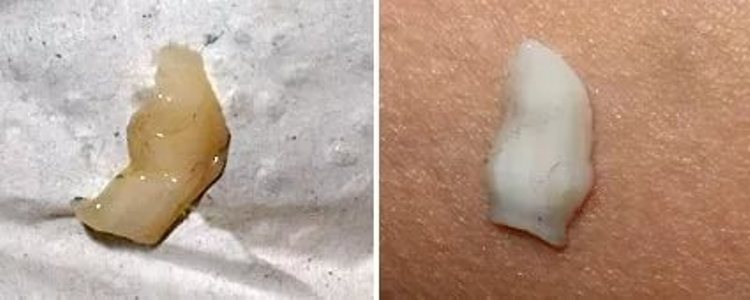
Symptoms of invasion
In the initial stage, the symptoms of a tapeworm are usually not pronounced. In 90% of cases, infected people do not even suspect that they are sick. Discomfort can only occur when proglottids leave the eggs through the anus. And even then, only if this happens not during a bowel movement, when the separated segments creep out on their own.
In the future, the symptoms of infection are becoming more pronounced, and the harm to the body from invasion increases. The main manifestations of teniarinhoza include.
In the initial stage:
- Allergic reactions - as the body's response to toxins secreted by worms.
- Nausea and heartburn. It manifests itself usually in 2-3 weeks of invasion.
In the middle and late stages:
- Breaking stool Occurs most often on the 8th week of infection.
- Change in appetite.
- Insomnia, fatigue.
- Heartburn, nausea, vomiting.
- Pain in the intestines.
- Weight loss observed on the background of increased appetite.
In 70% of cases there is a decrease in gastric acidity. Radiography abdominal cavity may indicate the presence of changes.
On the side of the CNS, there are symptoms characteristic of normal fatigue.
- Headache.
- Fainting or fainting.
- Epilepsy, convulsions.
- Bad sleep.
A blood test shows eosinophilia and anemia. There is a decrease in immunity, leading to frequent colds, pneumonia, bronchitis, influenza.
With a complicated course of teniarinkhoz, intestinal obstruction, pancreatitis, cholangitis, appendicitis may occur.
Particularly dangerous consequences include provocation teniarinhoz cancer, Alzheimer's disease.

Consider the life cycle dangerous worm from the moment when his eggs leave the intestines of the final owner - man. They can go outside with feces, but not necessarily. Proglottids — fragments of bovine tapeworm containing invasive eggs — are able to creep out through the anus on their own.
Once in the environment, most of the eggs die. Oncospheres do not have a great vitality. They withstand moderate cooling, but quickly die when they are exposed to sunlight. Another part of the eggs, contaminated grass or other food, is swallowed by animals during feeding.
Caught in the gastrointestinal tract of oncospheres penetrate through the mucous membrane of the intestinal wall into the circulatory system of the animal and are carried by blood throughout the body. They are mainly deposited in the muscles, but can also get into other organs, for example, in the brain of the reindeer.
After about 4 months, oncospheres are transformed into larvae (Finns), which can live in the animal's tissues for 1-2 years, after which they die. If a person infected with Finnish raw or half-baked meat is eaten by a person, he becomes infected with the tenienarhoz.
The harm done to a person by a tapeworm that lives in its intestine is diverse:


These photographs show the enormous size of an unarmed tapeworm.
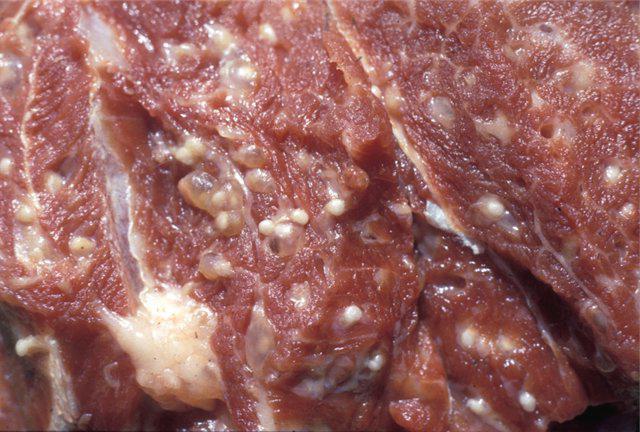
And this is perhaps the most useful photographic information for ordinary users, showing how Finnish meat looks like, which in no case can be bought, no matter how much it costs.
Most often, teniarinhoz fall ill people, by the nature of their activities associated with animal husbandry and its products - cattlemen, cutters and sellers of meat, cooks.
Important. A person infected with a bull chain is not dangerous to others. The eggs, which he releases, must necessarily go through the stage of development in the organism of animals to the larvae (Finn), which are an invasive form for humans. Oncospheres can be swallowed by chance, but they will not develop in a person.
Preventive measures to prevent the spread of teniarinhoz are divided into two categories. Measures conducted by public services, and the rules that must be followed by a private person so as not to become infected with helminthiasis.
- Veterinary services control raw meat entering stores and markets using slices of about 40 cm². If more than 3 Finns are found at the cut, the whole batch of meat is considered unfit for sale.
- Identification and deworming of persons infected with teniarinhoz, mainly livestock breeders and owners of CGS, is carried out.
- Measures are being taken to protect the environment from contamination by faeces. The sanitary conditions of livestock are monitored.
- Conducted sanitary and educational work with the population.
To avoid infection, individuals are advised to follow the following rules.
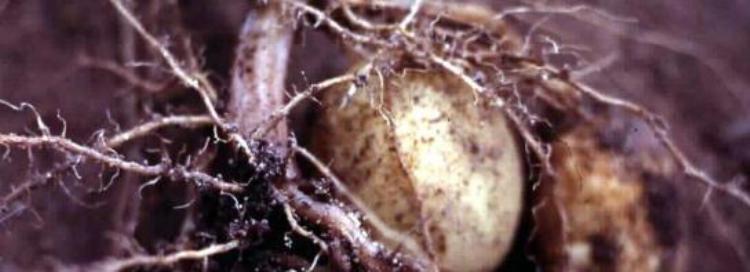
Conclusion
The bovine tapeworm does not belong to the most dangerous helminths, such, for example, as echinococcus or pork tapeworm. But this does not mean that it can be treated lightly. Complications of teniarinhoza are fraught with serious health problems.
Therefore, having found symptoms in oneself that may indicate the presence of a tapeworm, it is necessary to visit a doctor as soon as possible for a more detailed examination.
Bull tsepnu affect the intestines of man and cause periodic spasms and pain. Infection with these worms is fraught dangerous consequences for good health. Moreover, the danger is not only adults, but also their larvae. Pig and bull tapewormSevere complications can be obtained if several representatives of this species settle at the same time. Their sizes can reach 6 meters, some specimens are even larger. For several years, bovine and porcine can live in humans. One can only imagine what harm they will cause during this time. Bulls structureThe bull, or it is also called unarmed, the tapeworm has an adult body length of almost 6 meters. The head is round and has several suckers. Next comes a thin neck, which is a growth zone, passing into the body of the worm. The body of the ox chain consists of separate segments. Younger are closer to the front of the body. All of them are hermaphroditic, that is, both female and male sex cells develop. There is no need for the presence of another individual for fertilization. Mature segments are closer to the end of the body. If you carefully consider them, you can find inside a huge number of eggs. As they mature, the segments become detached and leave the intestine to the outside.
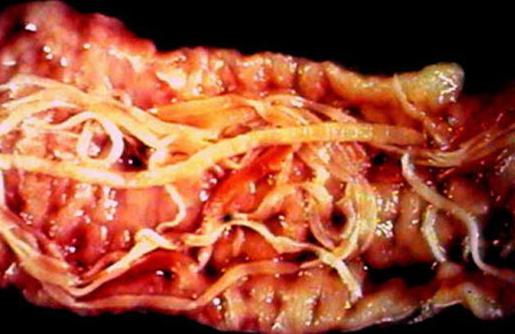 Eggs have a round or oval shape and a transparent shell. An embryo develops inside, having several pairs of hooks. It would seem that once the segments are detached and leave the human body, then gradually the length of the worm should decrease. But this does not happen, because new ones are constantly being educated. This may continue for quite a long time. The life cycle of the bull chainIn the environment there is an active pollution by eggs of grass, pastures, places of keeping animals. Together with the feed, they are inside the body of a cow or other cattle. There, having reached the muscles with blood flow, after some time they turn into larvae, which are called Finns. They are only about 0.5 centimeters in size, the vial with liquid inside is white. In this environment and there is a small head of a bull chain. Its structure is already such as that of an adult. The life cycle of a bull chain is such that Finns can stay in an animal’s body for several years and then die. During this time, they represent a danger to humans. Ways of infecting the bull chainIn a couple of months they will turn into adult worms. You can become infected through dirty hands, underwear, or food. If the body does not settle bovine, and pork tapeworm, then there is a danger that during vomiting larvae can get from the intestine into the stomach. From there, with a stream of blood, they can spread throughout the body and get into other organs. Symptoms of bovine chain infectionAfter the bull chains get into the human body, it begins incubation period. It can have a different duration, usually from 8 to 14 weeks. In some cases, stretching occurs for several years. Often there are cases when the disease proceeds without any signs at all. But basically, if a person has a bullish tapeworm, the symptoms may be as follows: - Periodic abdominal pain.
- Bouts of nausea.
- Upset appetite - then there is an increase, then a complete absence.
- Vomiting.
- Unreasonable weight loss.
- Flatulence.
- Frequent urge to empty the bowel.
- Rumbling in abdomen.
Since, as a result of its vital activity, the worm bull harmful products exchange, which enter the bloodstream, headaches, dizziness, and sometimes even fainting are often observed.
 Especially at night, there is a periodic creep of segments from the anus. Diagnosing Bovine InfectionAs a rule, the diagnosis of teniarinhoz is not difficult. It is enough to conduct a laboratory study of human feces to detect the segments of the worm in it. Often used microscopy prianalny scraping using a native smear, thick smear on Kato. Although there are times when they do not give any result. Bull tsepny can also be detected by fluoroscopy after patients receiving a contrast solution. In the picture, the worm will be in the form of a strip of light color up to 1 centimeter wide. Do not hide from the doctor the symptoms of the disease, otherwise the consequences can be serious. Treatment of the disease with medicationsBasically the process is reduced to receive anthelmintic drugswhich include: - means "Fenasal";
- ethereal extract from fern rhizomes;
- medicine "Akrikhin".
The treatment regimen and set of drugs also depend on age group the patient. Those medicines that are used in adults are not recommended for children. Treatment regimens may vary. For example, the drug "Phenasal" can be used in two ways: - In the evening, a few hours after dinner, the patient drinks 0.5 teaspoons of baking soda, and after a few minutes, takes Fenasal, diluted in sweet water.
- By the same principle, medication is taken, only in the morning hours.
Essential fern extract is given in gelatin capsules, which are recommended to be taken on an empty stomach. The entire dose must be drunk within 30 minutes, and then after 1.5 hours, take a laxative. Breakfast can only be 2 hours after taking the medicine. If the stool does not follow on its own after taking the medicine, then an enema should be performed. When taking fern extract often appear side effects in the form of nausea, vomiting. In some cases, there is a violation of cardiovascular activity. It is urgently necessary to consult a doctor so that other appropriate treatment is prescribed. Treatment with the drug "Akrihin" is carried out in almost the same way as fern extract. The dose is calculated depending on the age of the patient and the mass of his body. During treatment, which can take a long time, laboratory tests are periodically prescribed. You can stop taking the drugs only after all the eggs come out of the body. Only then can we say that a person’s bullish tape does not live in humans anymore, the symptoms also completely disappear. Treatment of folk remediesSince most drugs for treatment exhibit toxic properties, not everyone can withstand such procedures. In this case, it is advisable to adopt the popular methods. - Peel the herring, chop it finely, mix with 3 cloves of garlic and 1 raw egg yolk, preferably homemade. Add 2 tablespoons of millet and mix until smooth. After that, add a glass of cooled boiled milk to this mixture.
- Within 2 days before the start of treatment it is necessary to switch to vegetarian food.
- In the morning, you need to make an enema with the following solution: mix 1 cup of infusion of tansy, prepared from 1 tablespoon of herbs and 250 ml of boiling water, with a glass of milk. The whole mixture must be introduced into the intestine and hold as long as possible.
- At the same time you can start taking the prepared composition. During the day, you need to take half a cup at regular intervals. This composition is recommended for use during the week, while maintaining a vegetarian diet.

It may be advisable to take the following collection: insist in a thermos 2 tablespoons of a mixture of chamomile, tansy, and wormwood. It is necessary to take in the morning on an empty stomach in 200 ml for 5 days. Given the cycle of bovine tapeworm, we can conclude that treatment should be carried out for a long time, until all signs of infection disappear. Complications teniarinhozaIf the disease is detected at the initial stage, then there are practically no complications. In some patients it is possible to diagnose colic, which provoke segments that have penetrated the vermiform process. Bull tsepny can cause perforation of the intestine, as its suckers and hooks injure its surface. Prevention of bovine chain infection
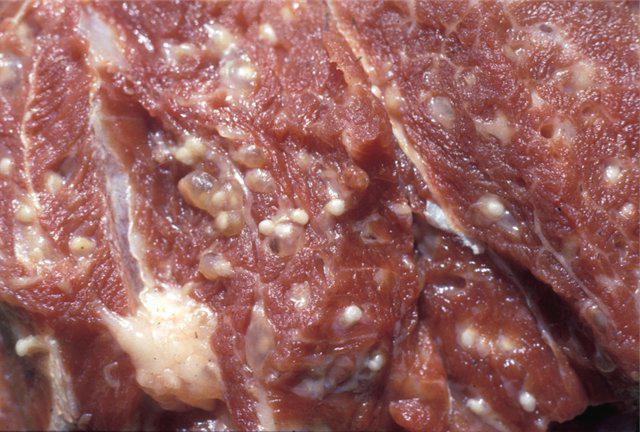
|

 The main symptoms of the disease:
The main symptoms of the disease:






















